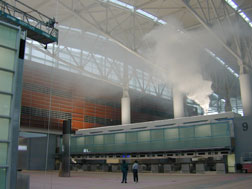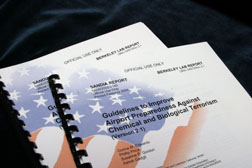NEWS RELEASES
FOR IMMEDIATE RELEASE
November 10, 2005
Airport protection guidelines to be distributed to emergency planners and airport executives
Sandia, Lawrence Berkeley Labs developed document to help guard against chemical and biological threats
 In developing “Guidelines to Improve Airport
Preparedness Against Chemical and Biological Terrorism”,
Sandia and its collaborators conducted research to understand
how toxic agents would spread through an airport. They also
studied the effectiveness of HVAC responses and conducted
extensive gas and smoke tracer tests, leading to a set of
recommendations targeted at improving the preparedness of
airports and other facilities with wide-open, interconnected
spaces.
In developing “Guidelines to Improve Airport
Preparedness Against Chemical and Biological Terrorism”,
Sandia and its collaborators conducted research to understand
how toxic agents would spread through an airport. They also
studied the effectiveness of HVAC responses and conducted
extensive gas and smoke tracer tests, leading to a set of
recommendations targeted at improving the preparedness of
airports and other facilities with wide-open, interconnected
spaces.Download 300dpi JPEG image, “airport-smoke-test.jpg,” 332K (Media are welcome to download/publish this image with related news stories.)
LIVERMORE, Calif. — A published report developed by a joint team of researchers from Sandia National Laboratories (SNL) and Lawrence Berkeley National Laboratory (LBNL) is being distributed to airport executives and emergency planners and is expected to aid security managers of airports and other transportation facilities in reducing the risk of chemical and biological attacks.
Sandia is a National Nuclear Security Administration (NNSA) laboratory. The research leading to the development of the guidance document was funded by the Department of Homeland Security.
“Guidelines to Improve Airport Preparedness Against Chemical and Biological Terrorism” is a 100-page document that makes concrete recommendations on improving security and assessing vulnerable areas, and helps its readers understand the nature of chemical and biological attacks. The report has been turned over to Airports Council International (ACI) and the American Association of Airport Executives (AAAE), two large organizations that together represent the interests of thousands of airport personnel and facilities in the U.S. and around the world.
The project was an extension of PROACT (Protective and Responsive Options for Airport Counter-Terrorism), a five-year Sandia-led program most recently supported by the Department of Homeland Security. LBNL became part of the PROACT effort in 2003 and joined forces with Sandia on the development of the guidance document.
In addition to the ACI and AAAE’s distribution plans, the Transportation Security Administration (TSA) has distributed the document to its own staff at the nation’s highest threat airports, and plans to incorporate portions of the guidelines into its existing document, Recommended Security Guidelines for Airport Planning, Design, and Construction.
Sandia/California’s Systems Studies and Systems Research Group developed the new guide, with researcher Donna Edwards and department manager Susanna Gordon in the lead. They worked with colleagues at Berkeley Lab whose team was headed by Ashok Gadgil and Phil Price of the Environmental Energy Technologies Division. Gadgil is leader of the Airflow and Pollutant Transport Group.
“We wanted to offer airport planners a user-friendly guide that gives them a clear understanding of chem/bio defense of their facilities and concrete steps they can take to assess and improve their current readiness levels,” said Edwards, the lead author of the report. Readers of the guide, she said, will be armed with the information necessary to determine what kinds of physical or system upgrades are required for their facilities, or whether an outside consultant is needed. The guidance contained in the document is also intended to help airport personnel deter high-consequence chem/bio attacks through targeted physical security measures, and to mitigate the impact of an attack through passive protection (measures that reduce impact even in the absence of response) and active response measures.
 Though the full report is classified as "Official
Use Only," an unclassified version of “Guidelines
to Improve Airport Preparedness Against Chemical and Biological
Terrorism”
is available for reporters (372K pdf).
Though the full report is classified as "Official
Use Only," an unclassified version of “Guidelines
to Improve Airport Preparedness Against Chemical and Biological
Terrorism”
is available for reporters (372K pdf).Gordon points out that airports and the TSA are already well equipped to deal with explosives and other conventional weapons. But the nature of a chem/bio threat, she says, is far different, and a comprehensive guide is needed to instruct airport facilities on how to deal with such a threat.
The guide begins with an overview of the chem/bio threat, including an examination of past incidents, specific chemical and biological agents, and potential scenarios that airport planners should consider. Subsequent chapter themes include vulnerability assessments, targeted physical security measures, passive protection measures, and active responses to mitigate the consequences of attack.
In developing the guide, Sandia drew extensively on knowledge gained from its collaboration with San Francisco International Airport under the PROTECT and PROACT programs (both initiated by the Department of Energy and continued under the Department of Homeland Security). Insight was also gleaned from Sandia’s participation in the Department of Defense’s Biological Defense Initiative and guidelines Sandia developed for other sites, and from other existing guidelines for building protection such as by the Center for Disease Control/National Institute for Occupational Safety and Health and by the U.S. Army Edgewood Chemical Biological Center (ECBC).
Berkeley Lab has extensive expertise in airflows and pollutant transport through buildings, including important practical knowledge such as the state and capability of a typical facility's heating/ventilating/air-conditioning (HVAC) system and the value of various types of filtration against biological threats. In addition, Berkeley Lab previously produced a document intended to help building owners understand and defend themselves from chemical and biological threats (securebuildings.lbl.gov/info.html), experience that proved valuable as the new airport guidelines were developed.
In collaboration with SFO, Sandia conducted research over the past few years to understand how agents would spread through an airport. They also studied the effectiveness of HVAC responses, conducting extensive gas and smoke tracer tests at SFO. Together, Sandia and Berkeley were able to create a set of specific prioritized recommendations targeted at improving the preparedness of airports and other facilities with wide-open interconnected spaces against chemical and biological terrorism.
Berkeley Lab and Sandia collaborated to prioritize possible improvements in facility security, such as the question of whether it is more important to prevent access to HVAC mechanical rooms or to provide better video coverage of areas in the terminal building.
“We understand that no airport will look identical or respond in precisely the same fashion,” Edwards says. “But the starting point for any facility is the same: gaining a thorough understanding of the specific threats and the characteristics of those threats, which in this case involves chemical and biological agent attack. Only then can you begin to look at plausible responses and facility ‘hardening’ measures. The ultimate goal, of course, is to protect airport facility users and save lives in the event of a terror attack.”
To develop the guide, the researchers worked extensively with airport managers at San Francisco International Airport, who provided insights into their security measures, and strategies for improving security. The Sandia-Berkeley team sent the draft document to reviewers at other airports around the country to ensure that it reflected the best thinking of security managers. Although focused on airports, the document is also relevant to transportation facilities such as train and bus stations and ports.
Sandia is a multiprogram laboratory operated by Sandia Corporation, a Lockheed Martin company, for the U.S. Department of Energy’s National Nuclear Security Administration. Sandia has major R&D responsibilities in national security, energy and environmental technologies, and economic competitiveness.
Sandia media contact: Mike Janes, mejanes@sandia.gov, (925) 294-2447